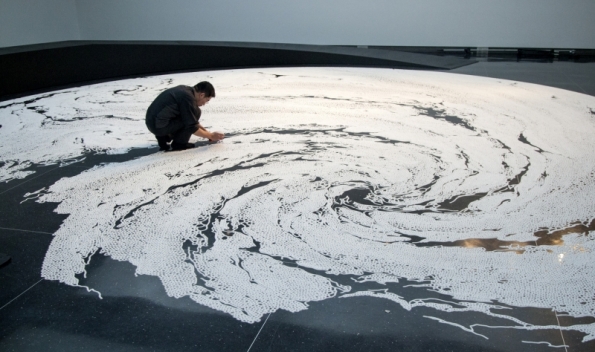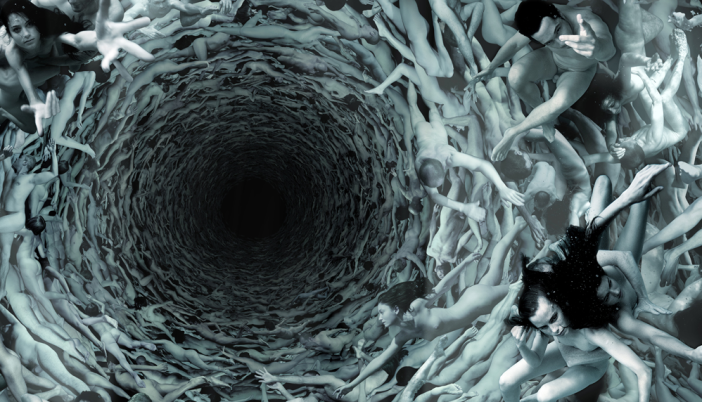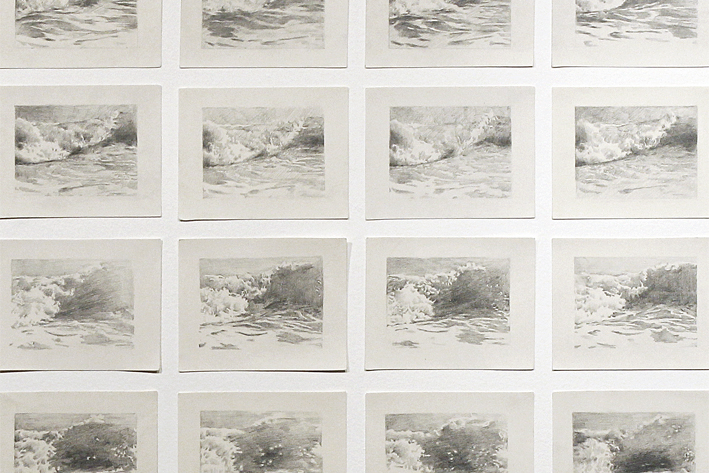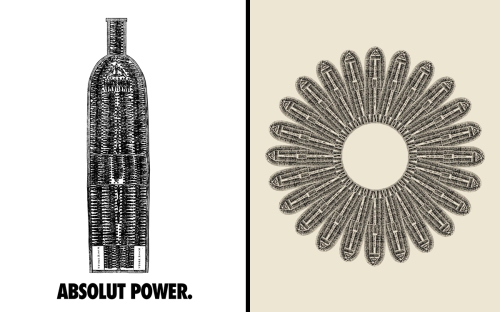Category: Multimedia
The Russian Ending, (2001) Tacita Dean
The Russian Ending
Portfolio of twenty black and white photogravures with etching collectively entitled The Russian Ending. The portfolio was printed by Niels Borch Jensen, Copenhagen and published by Peter Blum Editions, New York in an edition of thirty-five; Tate’s copy is the fifth of ten artist’s proofs. Each image in the portfolio is derived from a postcard collected by the artist in her visits to European flea markets. Most of the images depict accidents and disasters, both man-made and natural. Superimposed on each image are white handwritten notes in the style of film directions with instructions for lighting, sound and camera movements, suggesting that the each picture is the working note for a film. The title of the series is taken from a convention in the early years of the Danish film industry when each film was produced in two versions, one with a happy ending for the American market, the other with a tragic ending for Russian audiences. Dean’s interventions encourage viewers to formulate narratives leading up to the tragic denouements in the prints, engaging and implicating the audience in the creative process.

The black and white source photograph for The Wrecking of the Ngahere surveys a large ship in stormy waters as seen from the air. Water spills over the bow of the ship and the heavy swell almost engulfs the vessel from both sides. Frothing expanses of spume extend from the far left of the image. This image is one of several in the portfolio that depict disasters at sea; Dean’s fascination with often tragic narratives set on the ocean extends to her work in other media (see Disappearance at Sea, 1996, Tate T07455).
The Ngahere was a steamship that was wrecked off Greymouth on the west coast of New Zealand in 1924. As Dean’s notes recount, the ship beached and sank in ‘disturbed water’ leaving ‘no chance of rescue’. The camera directions specify a ‘long shot’ to ‘watch her go (a matter of moments)’. Towards the bottom right of the print the word ‘rock’ is scrawled in large letters. Above and below it are lines that could be snatches of dialogue from Dean’s imaginary film: ‘the sea’s got her now – bye bye’ and ‘she’s come a croppa’. The scene is described as ‘The Russian Ending (rough misadventure)’.
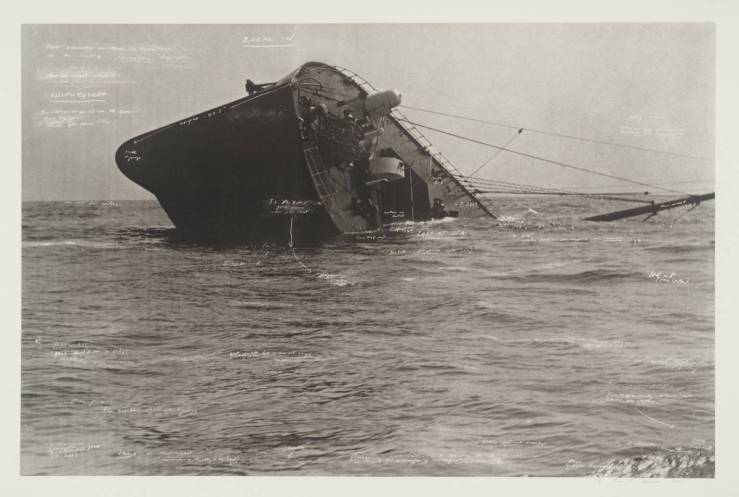
The black and white source image for The Sinking of the SS Plympton depicts a large ship capsized in a still sea. The ship has beached dramatically on its side and only a portion of the hull is visible above the water. Dean’s notes provide historical detail about the incident in the photograph, which she calls ‘the classic Russian Ending’. The shipwreck took place in ‘treacherous waters’ off the ‘Scilly Islands’ where a ‘southwesterly blew her onto the rocks’. Text superimposed on the water immediately in front of the ship provides a mournful litany of the casualties: ‘all hands lost … all crew lost … all lost … lost at sea’.
Additional notes on the print approach the image as the template for Dean’s fictional film scene. The hull of the ship is marked with detailed measurements and the comment that, at over forty feet long, it is ‘quite a prop’. Camera directions encourage a ‘zoom in’ while sound notes call for a choir singing off-screen as the ship goes under. At the bottom of the print are instructions for a sentimental flashback sequence showing the Plympton’s launch, a ‘happy day’ despite the fact that ‘the bottle did not break’.

The photograph on which The Story of Minke the Whale is based depicts a whale beached in shallow waters. A large pulley has been attached to the whale’s mouth; it is unclear from the image whether this is a means of capture or of attempted rescue. A slightly out of focus group of people including two children stand on a boat behind the whale looking down at the vast expanse of the mammal’s flesh. The scene appears to take place in an estuary; land is visible beyond an additional boat in the water.
Dean’s notes describe the scenario as ‘a cheap Moby Dick’ set on ‘a fjord in Denmark’. Her fictional film places the blame for the whale’s death on the onlookers: ‘they killed her … poor Minke, killed for her blubber’. In the artist’s narrative, the ‘audience’s sympathy [is] with the whale’. Dean draws attention to sentimental detail that echoes her film’s tone, including the whale’s ‘last toothless smile’.

The grainy black and white source image for Ship of Death shows a waterlogged boat in a stormy sea. Water cascades over the sides of the vessel, and the violent pitch of the waves has rendered the mast a dark blur. In its impressionistic depiction of a tempestuous seascape the photograph recalls the work of Joseph Mallord William Turner (1775-1851; see A Disaster at Sea, circa 1835, Tate N00558). The image also relates to Dean’s own fascination with adventures and misadventures at sea (see Disappearance at Sea, 1996, Tate T07455).
Dean’s notations superimposed on the found image emphasise the fiction that the picture is the still from a film. At the top left corner are the words ‘last scene’ and the work’s title. A shrouded figure is highlighted with the legend ‘ferryman’. ‘Slow movement’ suggests a long camera pan across the scene. The bottom right corner includes more allusive references to the image. The water is labeled ‘Styx’ and an arrow pointing off towards the right bearing the words ‘exit’ and ‘Hades’ suggests the ship’s descent to the underworld. The phrases ‘bye bye’, ‘it’s over’, ‘whence they say that no man ever returns’ and ‘end’ reinforce the finality of the ship’s fate.
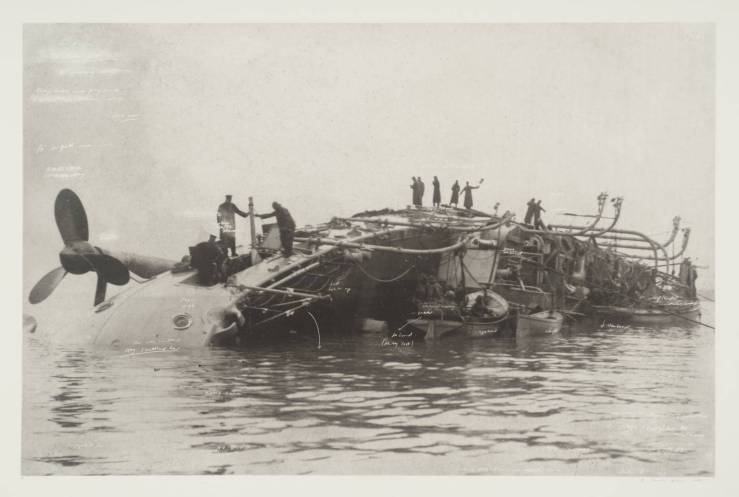
The photograph on which So They Sank Her! is based depicts a capsized ship. The large vessel is pictured on its side in shallow water; a propeller is visible on the far left of the image. Groups of men in heavy coats stand on the upturned side while several small boats congregate in front of the ship.
Dean’s notes provide a narrative contextualising the image as ‘a mutiny story’ dramatising ‘the sinking of a Royal Navy gunship’. The mutiny took place off the Isle of Wight in 1908. The men on the boat’s side are policemen, while the huddled masses in the rowboats are some of the captured mutineers. A solitary figure almost lost in the shadows is labeled ‘the ringleader’; he appears to be making his getaway.
Guernica Syndrome (2012), Fernando Sanchez Castillo
 The artist Fernando Sánchez Castillo examines the efficacy of history and historicity in films, sculptures, and performances. He scrutinizes the propagandistic mechanisms of memorials as well as of politi-cal myths, revealing their workings by means of in part satirical interventions. Sánchez Castillo is presenting his most recent work, Guernica Syndrome (2012). Under the artist’s supervision, the Azor, former dictator Francisco Franco’s pleasure yacht, was dismantled and turned into a multipart metal sculpture. Its conversion was also documented on film.
The artist Fernando Sánchez Castillo examines the efficacy of history and historicity in films, sculptures, and performances. He scrutinizes the propagandistic mechanisms of memorials as well as of politi-cal myths, revealing their workings by means of in part satirical interventions. Sánchez Castillo is presenting his most recent work, Guernica Syndrome (2012). Under the artist’s supervision, the Azor, former dictator Francisco Franco’s pleasure yacht, was dismantled and turned into a multipart metal sculpture. Its conversion was also documented on film.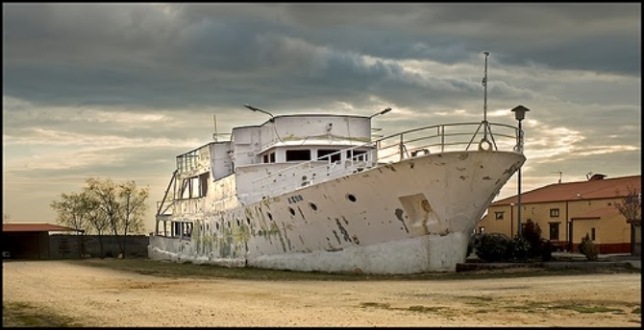
 Fernando Sánchez Castillo: Guernica Syndrome, 2012
Fernando Sánchez Castillo: Guernica Syndrome, 2012
Sánchez Castillo often uses concrete traces from the past as a point of departure and as the material for his analyses and transformations. With Guernica Syndrome, however, the artist explores an extremely charged relic of recent Spanish history that places the focus on events that have been forgotten or have not been dealt with. The yacht was a symbol of power and Franco’s political stage: he held important political discussions on board the boat, and in 1948 he met here several times with Juan de Borbón, Spain’s heir to the throne. In 1985, a huge scandal ensued after Minister President Felipe González spent his summer vacation on the Azor. The state acquired it at an auction for a small price on the condition that it would be subsequently scrapped. However, the new owner attempted to market the boat as an attraction, to establish it as an event location and political Mecca, yet his enterprise was unsuccessful. 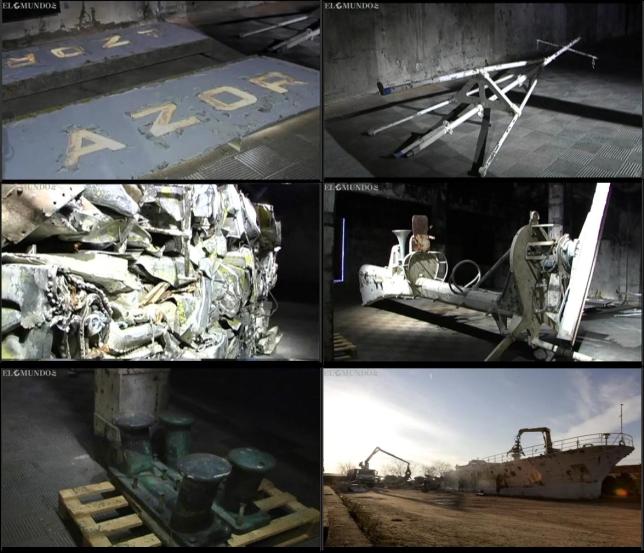 Fernando Sánchez Castillo finally bought the Azor in 2011 and had it dismantled to create a multipart sculpture consisting of more than forty blocks of metal, the boat’s mast, two benches, and additional individual parts that are now setting out on “the last trip.” In this new form and function, Franco’s historically and emotionally charged yacht makes formal reference to Minimal Art and its pursuit of logic and objectivity. At the same time, Guernica Syndrome inquires into the strategies of dealing with the past as well as of the suppression and glorification of history. How do power and its staging influence the present? How does Franco’s dictatorship continue to impact Spain and its population?
Fernando Sánchez Castillo finally bought the Azor in 2011 and had it dismantled to create a multipart sculpture consisting of more than forty blocks of metal, the boat’s mast, two benches, and additional individual parts that are now setting out on “the last trip.” In this new form and function, Franco’s historically and emotionally charged yacht makes formal reference to Minimal Art and its pursuit of logic and objectivity. At the same time, Guernica Syndrome inquires into the strategies of dealing with the past as well as of the suppression and glorification of history. How do power and its staging influence the present? How does Franco’s dictatorship continue to impact Spain and its population?
 Fernando Sánchez Castillo, Guernica Syndrome, 2012 (film still). Video, color, 31:17 min, Courtesy Fernando Sánchez Castillo
Fernando Sánchez Castillo, Guernica Syndrome, 2012 (film still). Video, color, 31:17 min, Courtesy Fernando Sánchez Castillo
Motoi Yamamoto
Motoi Yamamoto is an internationally renowned artist who calls his native Japan home. Motoi is known for working with salt, often in the form of temporary, intricate, large-scale installations. Salt, a traditional symbol for purification and mourning in Japanese culture, is used in funeral rituals and by sumo wrestlers before matches. It is frequently placed in small piles at the entrance to restaurants and other businesses to ward off evil spirits and to attract benevolent ones. Motoi forged a connection to the substance while mourning the death of his sister, at the age of twenty-four, from brain cancer, and began to create art out of salt in an effort to preserve his memories of her. His art radiates an intense beauty and tranquility, but also conveys something ineffable, painful, and endless.
“Drawing a labyrinth with salt is like following a trace of my memory. Memories seem to change and vanish as time goes by; however, what I seek is to capture a frozen moment that cannot be attained through pictures or writings,” Motoi has said. “What I look for at the end of the act of drawing could be a feeling of touching a precious memory.”
Walid Ra’ad (The Atlas Group)
The Atlas group is a project established in 1999 to research and document the contemporary history of Lebanon.One of our aims with this project is to locate, preserve, study, and produce audio, visual, literary and other artifacts that shed light on the contemporary history of Leanon.

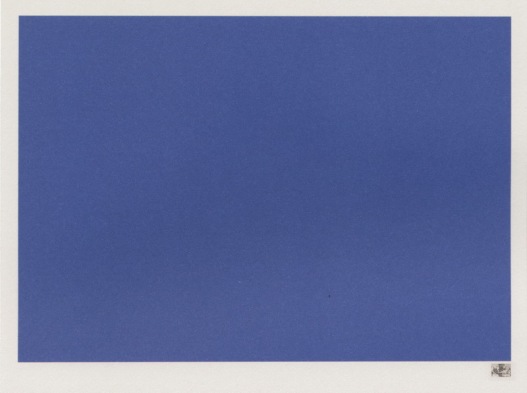 Secrets in the open sea
Secrets in the open sea
Category_File_Type_Plates: [cat. FD]_Secrets_Photographs_016 – 021
Media: Color photographs
Dimension: 111 х 173 cm
Date: 1994
Attributed to: Anonymous
Secrets in the Open Sea consists of 6 large photographic prints that were found buried 32m under the rubble during the 1992 demolition of Beirut’s war-damaged commercial districts. The prints were different shades of blue and each measured 110x183cm. The Lebanese government entrusted the prints to The Atlas Group in early 1994 for preservation and analysis.
In late 1994, The Atlas Group sent the prints to laboratories in France and the United States for technical analysis. Remarkably, the laboratories recovered small black and white latent images from the prints, and the small images represent group portraits of men and women. The Atlas Group was able to identify all the individuals represented in the small black and white prints, and it turned out that they were all individuals who had been found dead in the Mediterranean between 1975 and 1990.
The Atlas Group published its findings in a report in December 1996. In the report, no determination was made about the size of the large prints nor about their colour.
I Only Wish That I Could Weep
1996-2003 | Video, mute | 7’36”
This ‘document’ is attributed to a Lebanese Army intelligence officer, Operator #17, who was assigned to monitor the Corniche, a seaside boardwalk in Beirut. From 1996 onwards, and for some unknown reasons, the officer decided to videotape the sunset instead of his assigned targets. The videotape was donated by Operator #17 to The Atlas Group in 1998.
Cabinets, Mark Dion
Since the early 1990s, Mark Dion has examined the ways in which dominant ideologies and public institutions shape our understanding of history, knowledge, and the natural world. Appropriating archaeological and other scientific methods of collecting, ordering, and exhibiting objects, the artist creates works that address distinctions between objective scientific methods and subjective influences. By locating the roots of environmental politics and public policy in the construction of knowledge about nature, Dion questions the authoritative role of the scientific voice in contemporary society.


Cabinet of Marine Debris



 Cabinet of Marine invertebrates
Cabinet of Marine invertebrates
Into the Maelstrom, Zoé T. Vizcaíno
Zoé T. Vizcaíno – Ciudad de México, 1979
By definition a vortex it’s a swirling mass typified by natural forces such as the whirlpool, tornado, or cyclone. This essential dynamism involves a rotary motion that derives from or includes a spiral whirling. A Maelstrom is a colossal natural phenomenon composed of irregularities in currents, flows and tides that are capable of generating powerful whirlpools that move forth constantly and rapidly. They are permanent oscillations between creation and destruction. I’m interested in emphasizing the idea of a vortex as a primary model, as a dynamic and coherent structural energy capable of generating a centripetal force that drags and concentrates matter into invisible depths. While these depths remain impenetrable, the surface perturbations- the wheeling and foaming streaked atop the sea are ever-present records of the density and force that is drawn below.

Formally, Into the maelstrom (2011-2013) explores and documents the world’s two most powerful whirlpools. Into the maelstrom consists of research and production in both video and photography. The first part was done during the summer of 2011 at the Lofoten Islands and at Saltstraumen- a small town in Northern Norway. The second part was executed during the spring of 2013 at the inland island Shikoku, at Naruto, Tokushima, Japan.
Superunknown (Alive in The), 2010, Xaviera Simmons
 Superunknown (Alive in The) installation, a large-scale montage, consisting of forty-two found photographs of migrants traveling by boat in the open sea. Drawn from newspapers, travel magazines, and the websites of organizations like Human Rights Watch, the photographs depict peoplewho have left their lives behind for a journey into the unknown. Like Simmons’s other photographic work, this one engages tactics of appropriation, and like her wall sculpture, Wilderness, it is produced through a process of accumulation. More significantly, however, the condition of being mobile, uprooted, in transit, is—through the repetition and reframing of this subject—posited as a more universal condition than we might otherwise like to imagine. If Simmons’s work often focuses on nationalism and the American landscape, it is worth recalling that many of this nation’s early settlers arrived as “boat people.” The condition of being uprooted, indefinitely situated between departure and arrival, is nonetheless disturbing to nationalist ideals, as it blurs the boundaries that define nation states. It also perforates the lines between “us” and “them.” Ultimately, this seems to be a central aim of Simmons’s work. Her characters invoke a state of being between past and future identities, of being outside the established order—which is to say, a state of possibility.
Superunknown (Alive in The) installation, a large-scale montage, consisting of forty-two found photographs of migrants traveling by boat in the open sea. Drawn from newspapers, travel magazines, and the websites of organizations like Human Rights Watch, the photographs depict peoplewho have left their lives behind for a journey into the unknown. Like Simmons’s other photographic work, this one engages tactics of appropriation, and like her wall sculpture, Wilderness, it is produced through a process of accumulation. More significantly, however, the condition of being mobile, uprooted, in transit, is—through the repetition and reframing of this subject—posited as a more universal condition than we might otherwise like to imagine. If Simmons’s work often focuses on nationalism and the American landscape, it is worth recalling that many of this nation’s early settlers arrived as “boat people.” The condition of being uprooted, indefinitely situated between departure and arrival, is nonetheless disturbing to nationalist ideals, as it blurs the boundaries that define nation states. It also perforates the lines between “us” and “them.” Ultimately, this seems to be a central aim of Simmons’s work. Her characters invoke a state of being between past and future identities, of being outside the established order—which is to say, a state of possibility.Mar Invadido & Mar Caribe, Toni Capellan
TEHOM, Angelo Musco
Tehom is found in the opening verses of the Book of Genesis and is believed to come from the Sumerian word Tiamat, the name given to the Salt Water, and means “The Mother of All Life”, (Ti = Life, Ama = Mother).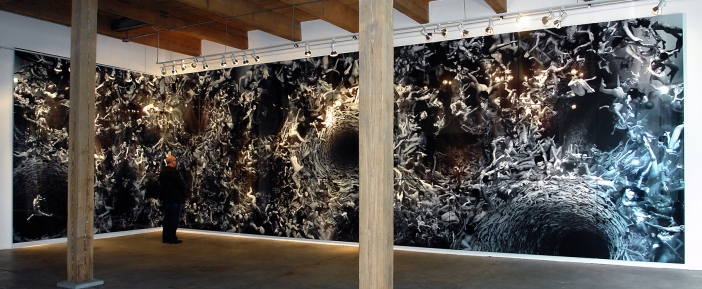
This aquatic inspired work, incorporates heavenly deep waters bursting with life, hellish dark spirals of humanity propelled with grace and tension, floating forms, sirens breaking the surface, and a rich organism reaching out to make contact and touch the viewer.
It took over two months working in various pools with a several small groups of volunteer models to gather thousands of images that were needed to complete the work. In this large amniotic landscape there are more than 500,000 bodies and the project took over two years to complete. Tehom is a multi-paneled installation measuring 12’ tall and 48’ long.
The Water, Moatz Nasr 2002
The Water, 2002
Single-channel video projection, 5 min
Time is closely tied to personal identity in this study of self and circumstance. Individuality is recast by time as the faces of Egyptian men, women, and children are briefly reflected in a puddle before a boot relentlessly stomps into the water, distorting, fragmenting, and transforming the images. Does this suggest that we are all in flux and that our circumstances are greater than our individual capacities to assert stable senses of self? Is the fragility of human time trampled by the forces of political time? Or do the quivering, shimmering faces that we see in Moataz’s work represent a looking glass that mediates and transcends time?
A video is projected in a dark room. The floor is isolated and turned into a pond of water. The video shows different portraits relected onto a puddle. The constantly moving nature of water makes the image unstable, showing the insecurity of human beings. Nevertheless, as soon as the image seems to stablize, it is broken by an unknown foot brutally stepping over the face. The viewer who enters the room steps on the water, where his own face and the faces of the other viewers are reflected, thus repeating the action of the video.
Seen at LACMA (David), Courtesy Galleria Continua, Italy
TO NEW HORIZONS, Erika Arzt / Juan Linares
TO NEW HORIZONS[1] –
ITINERARIOS, Fundación Botín, Santander 2010/2012
-215 pencils drawings on paper, 14×18,8cm
-Animation loop, 25seg.

Animation of a wave[2] crashing produced out of 215 drawings copied from the same number of still frames (produced manually in China by one of the different Oil Painting Villages that can be found in Xiamen[3]) extracted from the film ‘To New Horizons’ produced by General Motors for their 1939-40 New York World’s Fair exhibit Futurama. This film represented a vision of the society of the future as in 1960, a vision that is now the past.
———
[1] The 1939 New York World Fair exhibition that took place just after ‘The Great Depression’, became a modernity’s promise, ‘The World of Tomorrow’, as an attempt to reconstitute a national narrative of progress shattered by a traumatic past by means of the different propositions for the ideal society as represented by the different pavilions that the large corporations housed in the fair. This particular vision of a market driven economy, coincided in place and time with the one that other countries proposed at the Fair with their own promise of wholeness and coherence, thus generating a blurring of ideological distinctions between democratic and totalitarian systems.
The 2008 collapse of the international financial markets and the different economical crisis that have followed, has lead most of the western world into a deep crisis and contributed to confirm the consolidation of the influence in the World of some emerging countries such as China with their own particular version of ‘The World of Tomorrow’.
[2] About what we only knew vaguely, and in “vaguely” [vaguement], there is a “wave” [vague], and waves are the result of movements in the interior and exterior of the ocean, imprinting turbulences (in a non-linear fashion) on its surface. Etienne Chambaud and Benoit Maire on their collaborative project ‘Position actuelle de l’Idéalisme (The Current Position of Idealism)’.
[3] Xiamen is a coastal city in southeastern China. It was the port of trade first used by Europeans (mainly the Portuguese) in 1541 as part of their imperialistic, colonialist enterprises across the World in search of new trade posts. Xiamen was also one of the earliest Special Economic Zones created in the 1980s. Xiamen is now home to one of the bigger concentrations of artists in China working for businesses that specialises in the reproduction of images; from old masters to any other image that people from all over the world might send to them.
And the Sea Will Talk To You (Coco Fusco, 2012)
“I have learned to swim on dry land. It turns out to be better than doing it in the water. There is no fear of sinking because you are already at the bottom, and by the same logic, you are already drowned beforehand.”
 And the Sea Will Talk to You is a film set in a dark space where the audience is invited to sit on inner tubes to have the experience of being in the rafts used by Cubans in their attempt to emigrate to the United States. In the film, Coco Fusco weaves sombre yet hopeful accounts of journeys, intermittently juxtaposed with a woman’s description of her attempt to bring her mother’s ashes back to Cuba from the United States. The mise en scène, the vertiginous images of the Caribbean Sea and sky, and the pace and tension of the accounts in the film provide a metonymic experience for the viewers who are unexpectedly transposed to the journeys themselves.
And the Sea Will Talk to You is a film set in a dark space where the audience is invited to sit on inner tubes to have the experience of being in the rafts used by Cubans in their attempt to emigrate to the United States. In the film, Coco Fusco weaves sombre yet hopeful accounts of journeys, intermittently juxtaposed with a woman’s description of her attempt to bring her mother’s ashes back to Cuba from the United States. The mise en scène, the vertiginous images of the Caribbean Sea and sky, and the pace and tension of the accounts in the film provide a metonymic experience for the viewers who are unexpectedly transposed to the journeys themselves.
Politically, the subject of the film is particularly relevant in the United Kingdom as the country deals with the growing numbers of illegal immigration in Calais and the escalation of the European emigration crisis in the South of the continent, as well as the domestic debate on potential restrictions to free movement within the European Union. From a much more personal perspective, And the Sea Will Talk to You presents the viewer with as close an experience as is possible of both the motivations behind the decision to leave one’s own country as well as the actual life-threatening ordeal of emigration.
Robert Smithson & Myeongbeom Kim
Robert Smithson, Floating Island (Whitney Museum, 1970)

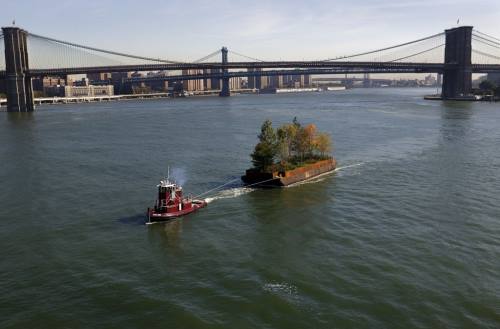 Myeongbeom Kim, Immigration (Tree boat) Ongoing project.Tree, Boat, Mixed media. Installation, Video. Korea
Myeongbeom Kim, Immigration (Tree boat) Ongoing project.Tree, Boat, Mixed media. Installation, Video. Korea

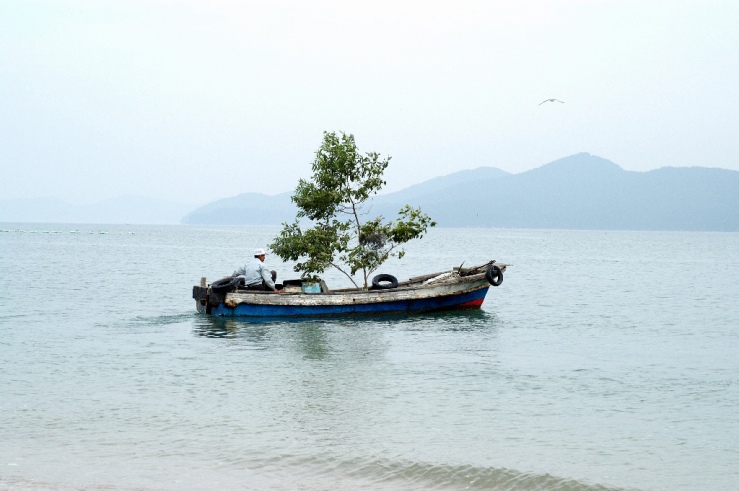 In Tree Boat, Myeongbeom Kim performs a meditative action by planting a tree on a small boat and taking it on a journey along a river. In Dorado, the route starts at La Plata River, which runs from the South of the island and flows into the North Atlantic Sea. But compared with previous renditions of the project, Tree Boat in Dorado reflects the luxuriant and abundant foliage of Puerto Rico. Choosing native plants, including a Ficus longifolia and a Tabebuia rosea, the project transformed from a single tree to a lavish garden. The choice of boat also significantly changed the meaning of the project. For the performance, the artist chose a local yola, a small boat commonly employed by people from adjacent islands, particularly the Dominican Republic and Cuba, to crossover illegally to Puerto Rico. The problematics of immigration, borders and territorial ownership, currently a major topic of conversation and debate on an international scale, then becomes an important factor to consider when interpreting the work. For Kim, the tree comes to represent the individual, who affected by unforeseeable circumstances, decides to leave his country ‘in search of the miraculous.’ The tree, an image that evokes permanence and stability, then initiates a dialectical relationship with its environment conditioned by immediate circumstances and probabilities.
In Tree Boat, Myeongbeom Kim performs a meditative action by planting a tree on a small boat and taking it on a journey along a river. In Dorado, the route starts at La Plata River, which runs from the South of the island and flows into the North Atlantic Sea. But compared with previous renditions of the project, Tree Boat in Dorado reflects the luxuriant and abundant foliage of Puerto Rico. Choosing native plants, including a Ficus longifolia and a Tabebuia rosea, the project transformed from a single tree to a lavish garden. The choice of boat also significantly changed the meaning of the project. For the performance, the artist chose a local yola, a small boat commonly employed by people from adjacent islands, particularly the Dominican Republic and Cuba, to crossover illegally to Puerto Rico. The problematics of immigration, borders and territorial ownership, currently a major topic of conversation and debate on an international scale, then becomes an important factor to consider when interpreting the work. For Kim, the tree comes to represent the individual, who affected by unforeseeable circumstances, decides to leave his country ‘in search of the miraculous.’ The tree, an image that evokes permanence and stability, then initiates a dialectical relationship with its environment conditioned by immediate circumstances and probabilities.
Returning to Smithson’s idea of the ‘non-site,’ Kim’s project elicits a sense of place but also of displacement. If our identities are forged by difference, time and movement, like our notion of space, then it is an ever evolving dialectic. Kim’s poetic and meditative gesture expands upon this idea; a personal journey that reveals the plural and engaging nature of our environment.
Carla Acevedo-Yates
Enrique Ramirez
Chilean Artist whose films and installations explore many themes that interest us:
‘Sus instalaciones fílmicas y fotografías tratan con las políticas de éxodos y exilios, y la discontinuidad de la memoria, pero para Ramírez esto siempre significa una ardua búsqueda en el imaginario subjetivo. Los vastos paisajes que usualmente aparecen en sus trabajos son concebidos como espacios geo-poéticos para la imaginación, territorios abiertos para ver y deambular. La manera de las imágenes es contemplativa; el paisaje, la brisa, el agua, la arena, todos ellos parecen trabajar juntos en el esfuerzo de instalar una mirada subjetiva.’
Absolut Power (2003), Hank Willis Thomas
Concerto in Black and Blue, David Hammons

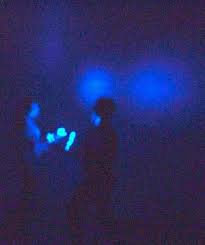 ¨Consists entirely of pitch-dark rooms that visitors are invited to explore with tiny flashlights in the company of other visitors whose presence is registered only by whisperings, footsteps, and firefly points of blue light¨
¨Consists entirely of pitch-dark rooms that visitors are invited to explore with tiny flashlights in the company of other visitors whose presence is registered only by whisperings, footsteps, and firefly points of blue light¨
¨Black and blue are highly charged colors in the cosmology of African American culture and historical experience. Night’s blackness holds a unique suggestion of terror in black American history. One is also reminded that the ancestors of many families escaped slavery under the cover of darkness, in the blue-black night. There is a sense, then, in which the entire history of Africans in North America can be told through reference to these two colors. In addition, there is the sense in which these two colors can be seen as metaphors for the impact the peoples of African ancestry who reside in North America have had on the world at large¨
ARTICLE: http://www.clairetancons.com/images/curatorial/cape/Haikunification/HAMMONS_NKA.pdf
Jun Nguyen-Hatsushiba
Explore his work, I don’t know if its related to what we are looking for: http://www.nguyen-hatsushiba.net/
Shipping Containers (2007), Chris Jordan
THE SLAVE SHIP (1840), TURNER
Was exhibited with lines from a poem that Turner had written in 1812:
“Aloft all hands, strike the top-masts and belay;
Yon angry setting sun and fierce-edged clouds
Declare the Typhon’s coming.
Before it sweeps your decks, throw overboard
The dead and dying – ne’er heed their chains
Hope, Hope, fallacious Hope!
Where is thy market now?”



